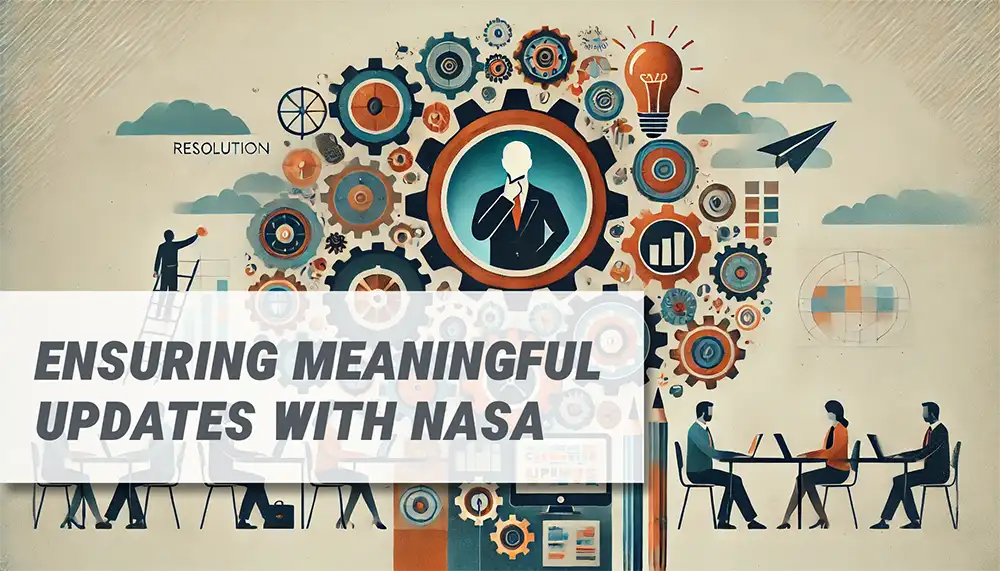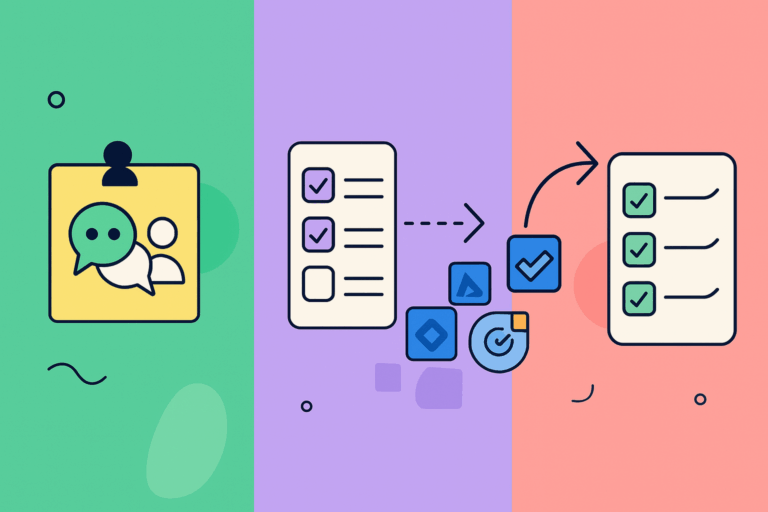In today’s fast-paced agile environments, effective stand up meetings have become an essential tool for team collaboration and project success. However, many teams struggle with making these brief sessions truly effective, often falling into the trap of meaningless updates and time-consuming discussions that derail the meeting’s purpose. This comprehensive guide will explore how to run a stand up meeting that keeps your entire team aligned, engaged, and productive using resolution’s NASA – Not Another Standup App.
Understanding the Fundamentals of Standup Meetings
Daily standup meetings serve as the heartbeat of agile project management. These quick, focused sessions are designed to synchronize team efforts and identify potential roadblocks before they impact project progress. It is said that the name “standup” comes from the practice of having participants stand during the meeting, naturally encouraging brevity and focus.
A well-run stand up meeting acts as a powerful catalyst for team communication and project momentum. It provides a regular platform for team members to share progress, seek help, and maintain accountability. However, achieving this level of effectiveness requires more than just gathering the entire team together each morning.
The Challenge of Meaningless Updates
One of the most common pain points in standup meetings is the prevalence of meaningless updates. These updates can take various forms, from vague statements about progress to irrelevant information that doesn’t contribute to the team’s goals. When team members share updates like “I worked on my tasks yesterday” or “I’ll continue working on the same thing today,” they’re missing the opportunity to provide valuable insights that could benefit the team.
Meaningless updates often stem from several root causes:
Lack of Preparation
When team members don’t take time to reflect on their progress and plan their day before the standup, they tend to provide off-the-cuff updates that lack substance. This impromptu approach not only wastes valuable meeting time but also fails to surface important issues that require team attention.
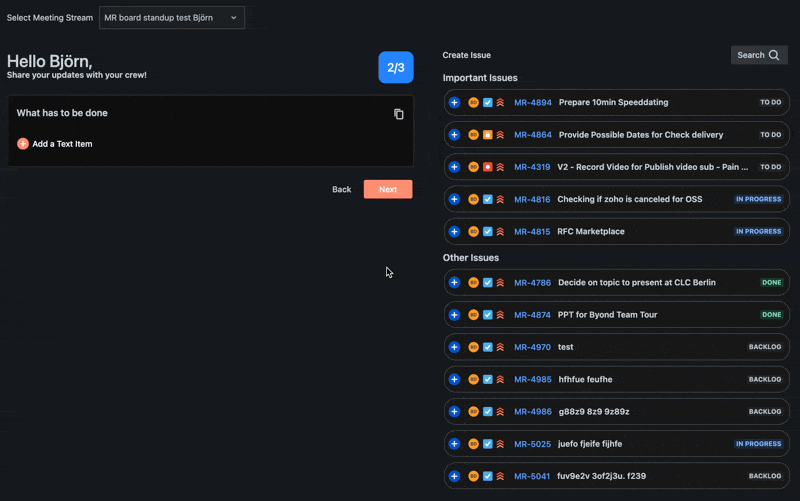
Unclear Guidelines
Without clear expectations about what constitutes a valuable update, team members may struggle to provide relevant information. Agile teams need explicit guidance on how to structure their updates and what details to include to make them meaningful for the entire group.
Insufficient Task Tracking
When agile teams don’t maintain their Jira, it becomes difficult to provide specific, progress-focused updates. This often leads to generic statements that don’t give the team real insight into project status or potential blockers.
How to Run an Effective Daily Standup Meeting
Running an effective stand-up meeting requires a deliberate approach and careful attention to structure and timing. Here’s how to transform your stand ups from routine check-ins to valuable team synchronization sessions:
Setting the Stage
Start by establishing a consistent framework for your stand up meetings. Set a standup meeting agenda and choose a regular time that works for all team members and stick to it. Morning stand-ups are often most effective as they allow teams to align their efforts for the day ahead. Select a location that’s easily accessible for everyone, whether it’s a physical meeting space or a virtual meeting room for remote teams.
Structuring the Discussion
The traditional three-question format provides a solid foundation for standup updates:
1. What did you accomplish yesterday or since the last meeting?
2. What are you working on today?
3. What blockers or impediments are in your way?
However, the key to making this format effective lies in how team members answer these questions. Encourage specific, measurable updates that tie directly to project goals and sprint objectives. For example, instead of saying “I worked on the login feature,” a team member should discuss progress and say “I completed the password reset functionality and it’s ready for code review.”
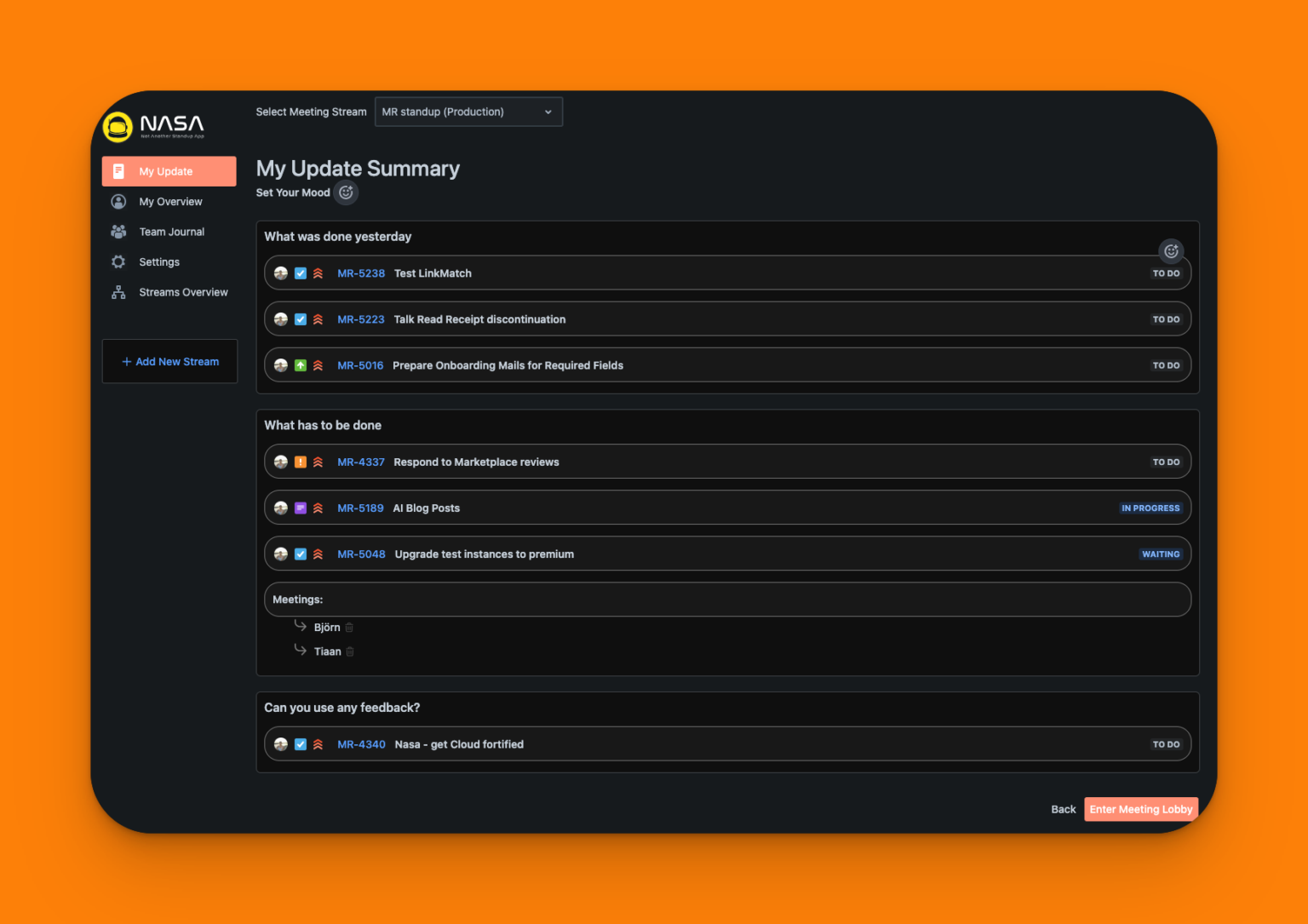
Managing Time Effectively
Time management is crucial for successful stand up meetings. Start precisely on time, regardless of who’s present. This practice encourages punctuality and respects the time of team members who arrive promptly. Use a visible timer providing every team member with a few minutes to keep the meeting on track, and don’t hesitate to politely interrupt detailed technical discussions that should be taken offline.
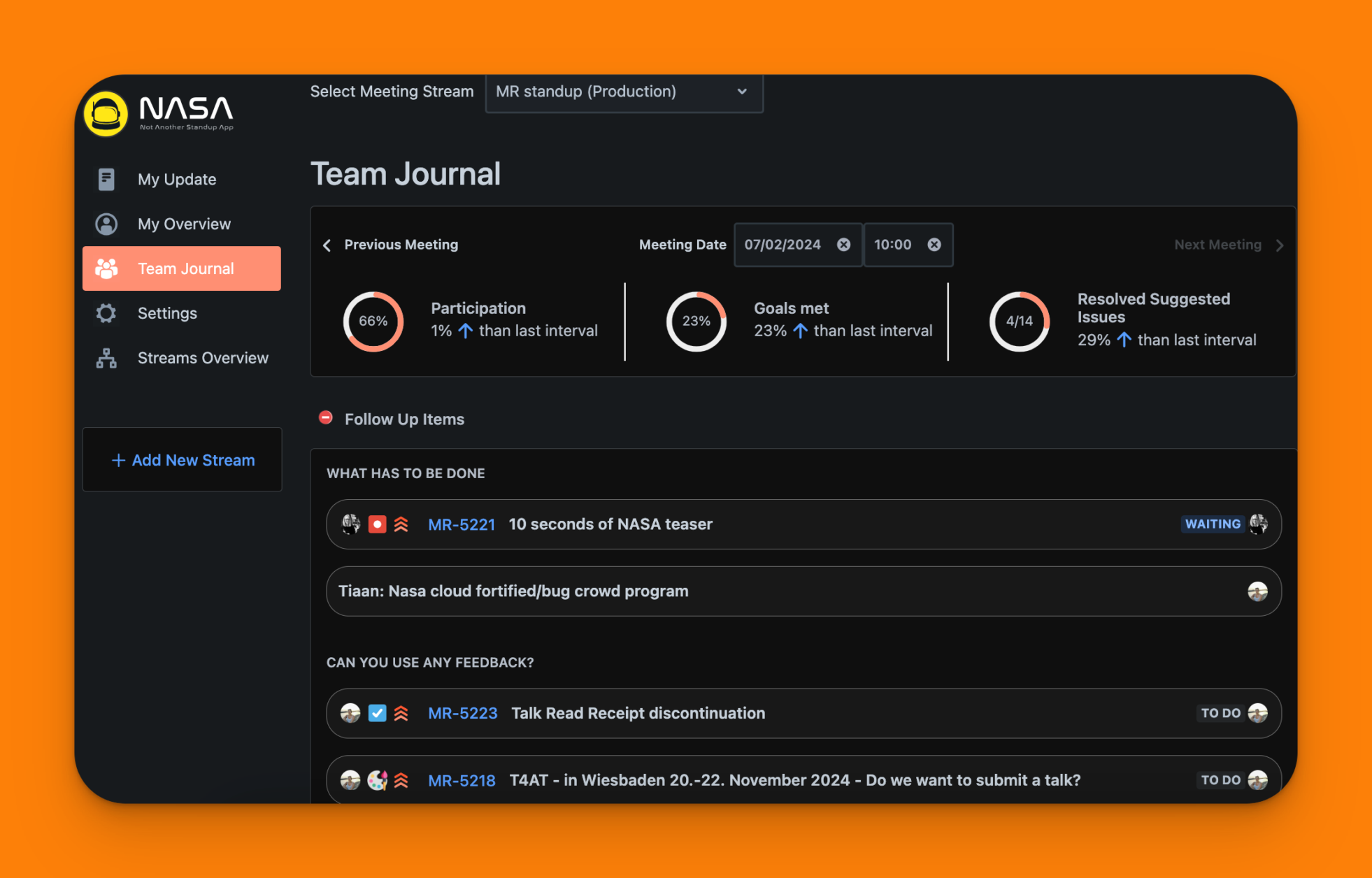
Focusing on Blockers
One of the most valuable aspects of daily stand up meetings is their ability to surface and address impediments quickly. When team members report blockers, ensure there’s a clear plan for resolution. This might mean assigning someone to help immediately after the standup or scheduling a separate problem-solving session for more complex issues.
Tools and Technology for Modern Stand-Ups
In today’s digital workplace, various tools can enhance the effectiveness of your stand up meeting. Project management platforms like Jira integrate directly with specialized standup tools, allowing remote teams to prepare updates in advance and track progress more effectively. These tools can help structure updates, track meeting metrics, and ensure that important issues don’t fall through the cracks.
The Role of Asynchronous Updates
For distributed agile teams or those working across different time zones, asynchronous standup updates can be particularly valuable. Team members can submit their updates ahead of time through NASA, allowing others to review the information during the live meeting. This approach often leads to more thoughtful updates and more focused discussions during the actual standup.
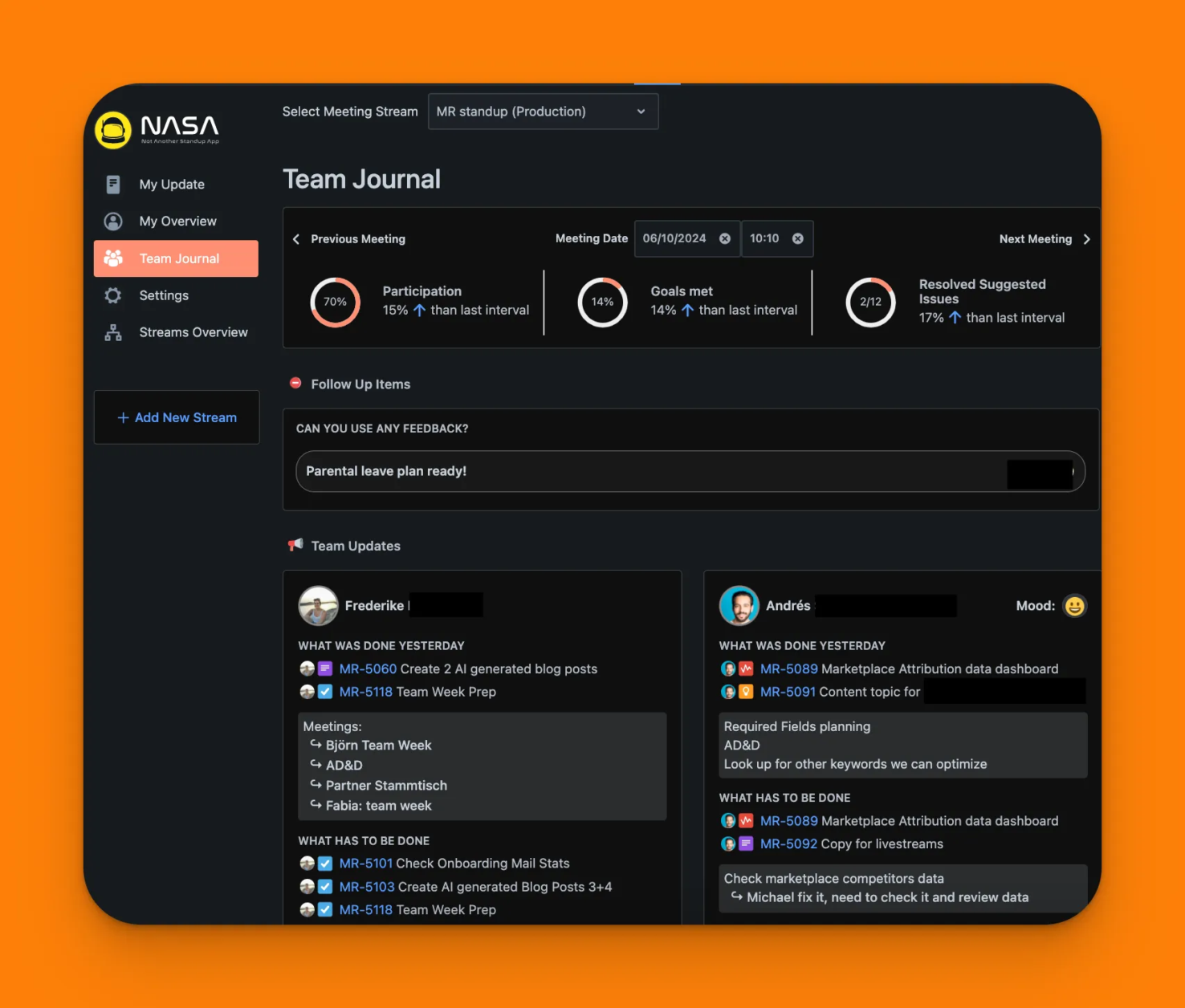
Measuring and Improving Standup Effectiveness
To ensure your stand-up meetings continue to provide value, you can check the Team Journal regularly. Tracked metrics such as goals met, participation rates, and the number of blockers identified will help identifying trends and areas for improvement.
Regular Retrospectives
Schedule periodic retrospectives specifically focused on your stand up meetings. Ask team members what’s working well and what could be improved. Some questions to consider:
Are updates providing valuable information to the team?
Is the meeting time and format working for everyone?
Are blockers being effectively identified and resolved?
Does everyone feel engaged and included in the process?
How NASA Ensures Meaningful Updates
NASA – Not Another Standup App for Jira is designed to address the issue of meaningless updates by providing tools and features that ensure every update is relevant, valuable, and actionable. Here’s how NASA can help:
Structured Format:
Guided Prompts: NASA uses a structured format for updates, typically following the “Yesterday, Today, Blockers” model. This structure helps team members focus on the most important information.
Clear Guidelines: The app provides clear guidelines on what constitutes a meaningful update, helping team members prepare effectively.
Asynchronous Updates:
Advance Preparation: NASA allows team members to submit their updates asynchronously before the stand up meeting. This approach encourages thorough preparation, ensuring that updates are clear and relevant.
Reduced Meeting Time: With updates prepared in advance, the actual standup meeting time is reduced, allowing for a quick review and discussion of key points.
Integration with Jira:
Centralized Information: By integrating with Jira, NASA links updates directly to Jira tasks. This integration ensures that all relevant information is centralized and easily accessible.
Real-Time Sync: Updates are synced in real-time, providing the latest information and reducing the need for manual updates and checks.
Focus on Blockers:
Highlighting Issues: NASA prompts team members to clearly identify blockers in their updates. This focus ensures that critical issues are highlighted and can be addressed promptly during the meeting.
Prioritization: By emphasizing blockers, NASA helps the team prioritize problem-solving over routine updates, making the meeting more productive.
Analytics and Reporting:
Insightful Data: NASA provides analytics and reports on standup meetings, offering insights into the quality and relevance of updates. These insights can help teams identify patterns and areas for improvement.
Continuous Improvement: Regular feedback from the app helps teams refine their standup process, ensuring that updates remain meaningful and relevant.
Implementing NASA to Ensure Meaningful Updates
Implementing NASA in your standup routine is straightforward and can lead to immediate improvements:
Setup and Integration:
Install NASA: Start by installing NASA from the Atlassian Marketplace and integrating it with your Jira instance.
Configuration: Configure the app to match your team’s workflow and preferences, ensuring that updates are linked to the relevant Jira tasks.
Training and Onboarding:
Educate Your Team: Provide training for your team on how to use NASA effectively. Emphasize the importance of preparing meaningful updates in advance and following the structured format.
Encourage Engagement: Encourage team members to actively engage with the app, reviewing updates asynchronously and coming to the standup meeting ready to discuss key points.
Monitor and Adjust:
Review Analytics: Use NASA’s analytics and reports to monitor the effectiveness of your standup meetings.
Continuous Improvement: Make adjustments based on the insights provided, continuously refining the process to ensure maximum efficiency.
Real-World Impact: NASA in Action
Teams that have adopted NASA for their standup meetings have reported significant improvements in the quality and relevance of updates. For instance, a software development team noticed that the focus on blockers and structured updates led to a 40% increase in resolved issues and a more engaged, motivated team. The integration with Jira ensured that all updates were directly linked to tasks, providing a clear overview of progress and priorities.
Conclusion
Running effective standup meetings requires a thoughtful balance of structure and flexibility. By focusing on meaningful updates, managing time effectively, and consistently working to improve the process, you can transform your standups from routine check-ins to valuable team synchronization sessions that drive project success.
Remember that the ultimate goal of any standup meeting is to help the team work more effectively together. Keep this purpose in mind as you implement and refine your standup process, and don’t be afraid to experiment with different approaches to find what works best for your team.
Success in standup meetings isn’t measured by perfect adherence to a specific format, but by how well they help your team collaborate, identify and resolve issues quickly, and maintain steady progress toward their goals. With consistent application of these principles and a commitment to continuous improvement, your standup meetings can become one of your team’s most valuable tools for project success.
